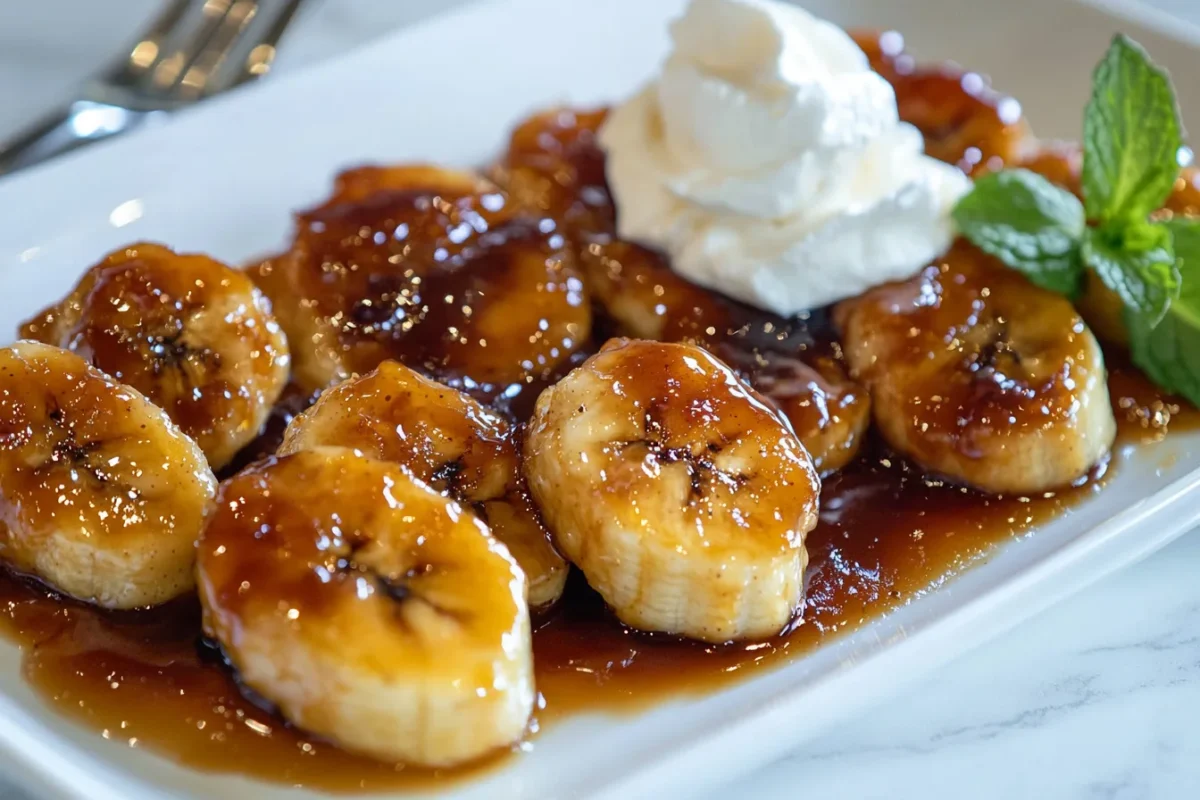Have you ever wondered how ripe should bananas be for foster to get that perfect flavor? It’s a common question, and getting it right makes all the difference. Too ripe, and they can turn mushy. Not ripe enough, and you miss out on the sweetness. But don’t worry—it’s simpler than you think!
Banana foster is a crowd-pleaser that’s both easy to make and incredibly versatile. Whether you’re serving it over ice cream or pairing it with pancakes, this dessert always impresses. The secret lies in choosing bananas at just the right stage of ripeness. Slightly spotty bananas are the perfect balance of sweet and firm—ideal for caramelization. Looking for another indulgent twist? Check out banana foster cheesecake for a dessert that’s rich, creamy, and undeniably delicious.
You’re going to love how simple it is to master this! Keep reading to learn the tips and tricks to pick the perfect bananas and create a dessert everyone will rave about.
Table of Contents
The Role of Banana Ripeness in Flavor and Texture
How Ripeness Impacts the Sweetness of Banana Foster
When it comes to banana foster, sweetness is key. The ripeness of bananas directly affects the flavor of this delicious dessert. Slightly spotty bananas hit the perfect balance—they’re sweet but not overpowering. First, as bananas ripen, their natural starches convert to sugar, giving them that caramel-like flavor. This makes the dish richer and more indulgent. For a detailed understanding of how sugar content changes during banana ripening, you can refer to this study.
On the other hand, bananas that are too green can taste bland. They lack the sweetness needed to complement the buttery caramel sauce. Overripe bananas, however, can overpower the dish, making it cloyingly sweet. Also, they’re too soft and mushy for proper cooking. By choosing spotty bananas, you’ll create a dessert that’s flavorful without being overly sweet.
So, when preparing banana foster, don’t underestimate the importance of ripeness. It’s the secret to balancing flavor. Try this tip, and you’ll love the results!
Achieving the Ideal Texture for Caramelization
The texture of bananas can make or break your banana foster. Spotty bananas with a firm, slightly soft texture are ideal.
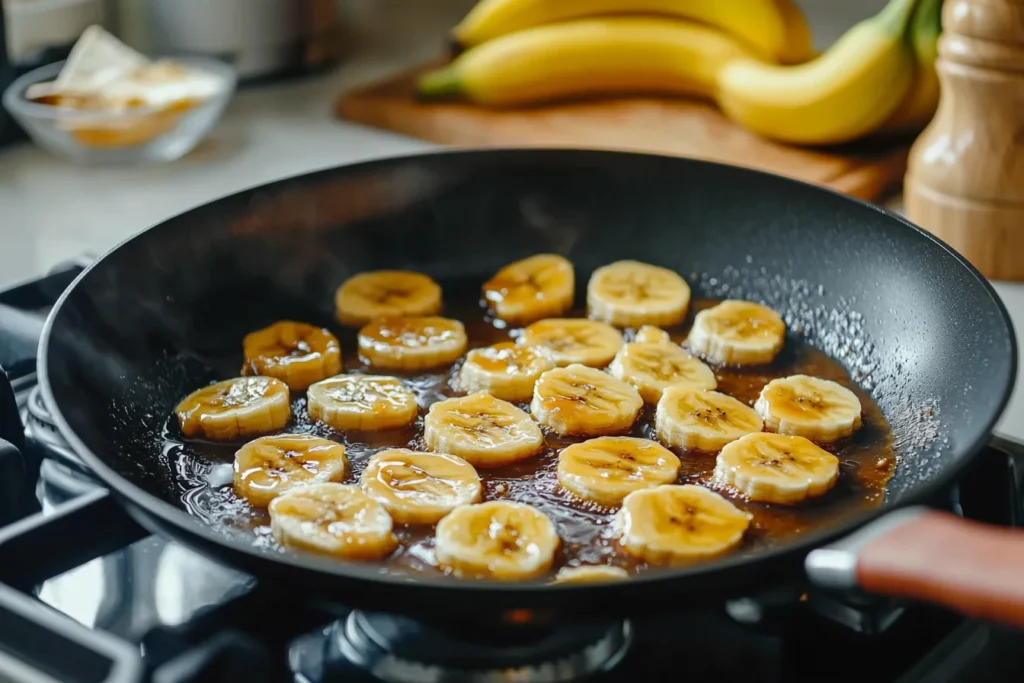
First, they hold their shape during cooking, giving you beautiful, caramelized slices. Additionally, ripe bananas are key for achieving that rich, caramelized flavor foster is known for. Green bananas, however, are too firm and fail to caramelize evenly.
Overripe bananas can be even worse. They become mushy and fall apart in the pan, turning your dessert into a sticky mess. Also, they absorb too much caramel sauce, making the dish overly sweet and soggy. Spotty bananas strike the right balance. They soften slightly when cooked, allowing the flavors of butter and caramel to infuse beautifully.
So, for the perfect banana foster, remember this rule: firm yet ripe bananas are your best bet. This small detail elevates your dessert’s texture from average to amazing. Give it a try—you’ll notice the difference immediately!
Choosing the Best Bananas for a Perfect Foster Dessert
Signs of Optimal Ripeness for Bananas in Cooking
Finding the right bananas for banana foster is easier than you think. Look for bananas with a golden yellow peel speckled with brown spots. First, these bananas are sweet but not overly sugary, which helps balance the caramel sauce. The brown spots indicate that natural sugars have developed, adding a rich flavor to your dish.
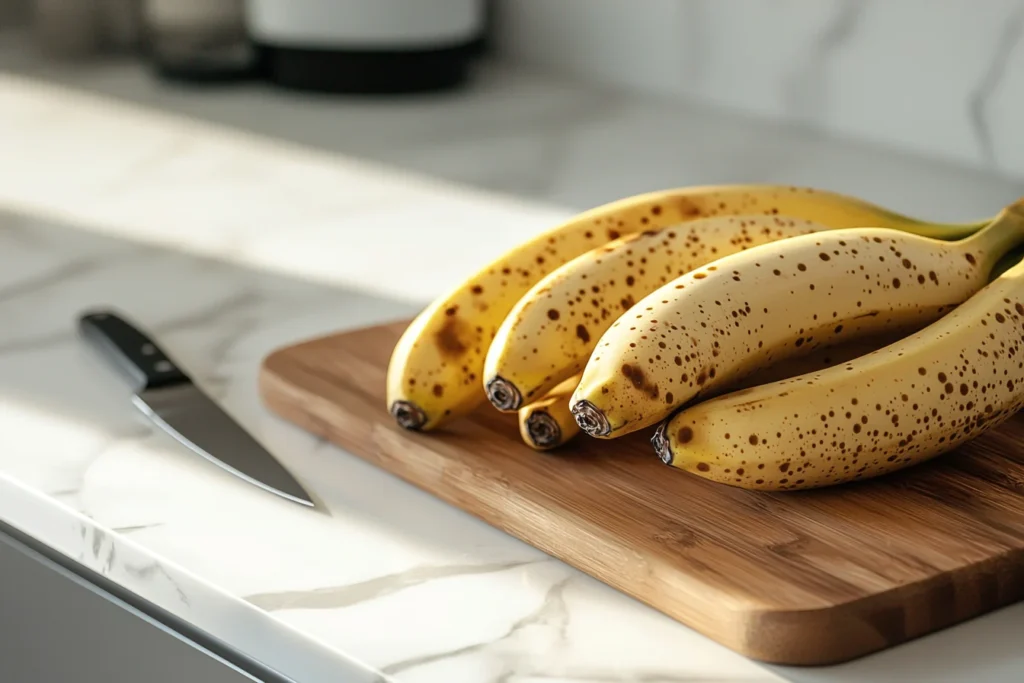
Also, the texture of these bananas is firm enough to hold their shape during cooking. If the bananas are entirely yellow without spots, they might lack the depth of sweetness needed. On the other hand, green bananas are too starchy and won’t caramelize well. By choosing slightly spotty bananas, you ensure a flavorful, visually appealing dessert.
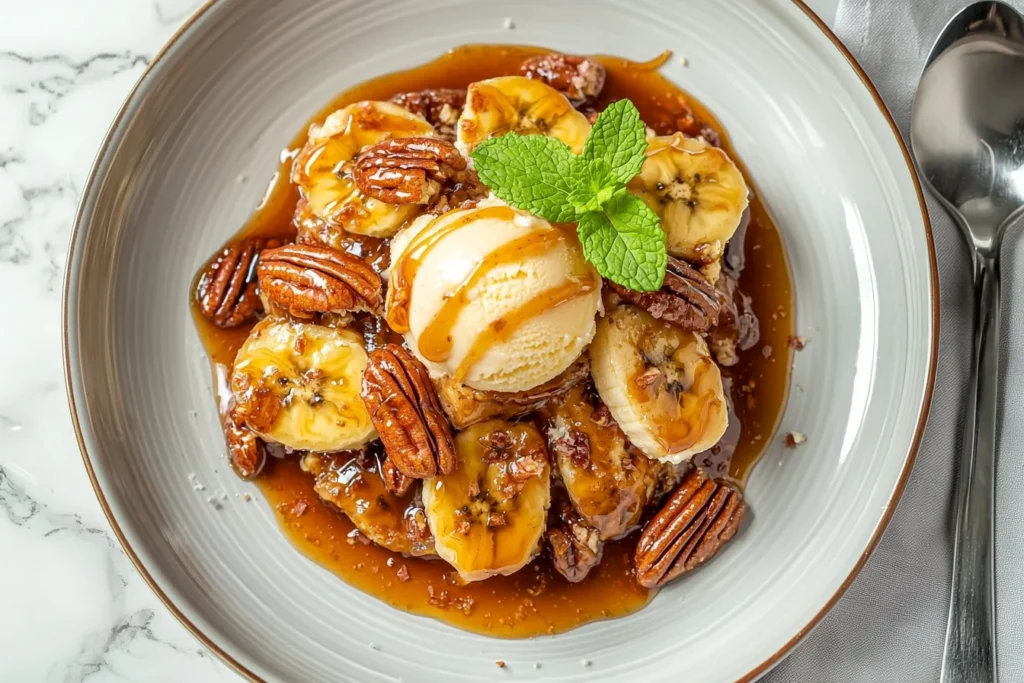
Curious about other ways to use versatile ingredients like bananas? Learn how they’re featured in savory buckwheat cakes recipes for a completely different flavor experience.
Next time you shop for bananas, remember: a few spots are your friend. This small step guarantees your banana foster will turn out perfectly every time. Try it—you’ll be amazed!
Avoiding Overripe or Underripe Bananas in Banana Foster
Bananas that are too ripe or underripe can ruin the magic of banana foster. Overripe bananas, while sweet, are often mushy. They break apart during cooking, creating a messy texture. First, this can overwhelm the sauce and make the dessert less appealing.
On the other hand, underripe bananas are too firm and starchy. They resist caramelization, leaving you with a bland, underwhelming flavor. Also, their tough texture doesn’t blend well with the buttery sauce. Spotty bananas hit the sweet spot—they’re soft enough to caramelize but firm enough to hold their shape.
By avoiding overly green or brown bananas, you’ll create a dessert that’s just right. Small details like this make all the difference. Trust this tip, and you’ll take your banana foster to the next level. Give it a try—you won’t regret it!
Understanding Banana Ripeness Stages for Foster Preparation
Green to Yellow: When to Avoid Using Bananas
Choosing the right bananas starts with understanding their ripeness stages. Green bananas may look appealing, but they are not ideal for banana foster. First, they lack the sweetness required to balance the rich, buttery sauce. Instead, they are starchy, which can result in an unpleasant taste when cooked.
As green bananas ripen to a bright yellow stage, their texture improves slightly. However, they still fall short of delivering the creamy sweetness banana foster demands. Additionally, yellow bananas without any spots might not caramelize effectively, leaving your dish less flavorful.
For the best results, patience is key. Let the bananas mature to the next stage of ripeness before using them in your recipe. By skipping green and bright yellow bananas, you’re already one step closer to making a dessert your family and friends will love.
Why Spotty Bananas Work Best for Banana Foster
Bananas with brown spots are the unsung heroes of banana foster. These bananas strike the perfect balance of sweetness and texture. First, the spots are a sign that natural sugars have fully developed, enhancing the caramelization process. When cooked, these bananas blend beautifully with the buttery sauce, creating a rich, indulgent flavor.
Also, spotty bananas are soft but still firm enough to hold their shape during cooking. Unlike overripe bananas, they won’t turn into mush, ensuring your dish looks as good as it tastes. Their sweetness complements the other ingredients without overpowering them, making every bite deliciously balanced.
So next time you see bananas with spots, don’t overlook them! They’re the secret ingredient for making your banana foster unforgettable. Trust the process, and your dessert will be the star of the table. You’ve got this!
Expert Tips for Selecting Bananas for Banana Foster
The Importance of Natural Sugar Development in Bananas
Bananas become sweeter and more flavorful as they ripen, thanks to the natural sugar development process. First, the starches in the fruit break down into sugars, which enhances the banana’s sweetness and aroma. This transformation is essential for creating the rich, caramelized flavor that makes banana foster irresistible.
When selecting bananas, look for those with brown spots, as they indicate peak sweetness. Additionally, these bananas caramelize better during cooking, adding depth to your dessert. Avoid underripe bananas because they haven’t developed their full sugar content yet, which can leave your dish bland.
By choosing bananas with the right sugar levels, you ensure your dessert reaches its full flavor potential. It’s a small detail that makes a big difference. Plus, your guests will love the perfectly balanced sweetness in every bite!
Storage and Handling Tips for Maintaining Perfect Ripeness
Proper storage is key to keeping bananas at their ideal ripeness for banana foster. Start by storing bananas at room temperature to allow them to ripen naturally. Avoid refrigeration during the early ripening stages, as cold temperatures can stall the process and alter the texture.
Once your bananas reach the perfect ripeness, you can extend their shelf life by placing them in the refrigerator. The skin may darken, but the fruit inside will remain sweet and ready to use. If you have ripe bananas but are not ready to cook, freezing them is another option. Peel, slice, and freeze them in an airtight container for later use.
With these simple tips, you can always have perfectly ripe bananas on hand for your dessert. It’s an easy way to make sure your banana foster turns out amazing every time. Try it and see the difference for yourself!
Common Mistakes When Using Bananas for Foster
Using Overripe Bananas: Why It Doesn’t Work
While overripe bananas might seem like a good choice because of their sweetness, they can actually ruin your banana foster. Overripe bananas are often too soft, making them difficult to slice and prone to turning mushy during cooking. This can result in a texture that’s less appealing and harder to enjoy.
In addition, overripe bananas can overpower the dish with their overly strong flavor. Instead of enhancing the dessert, their intense sweetness can mask the caramel and buttery notes that make banana foster so delightful. To avoid this, look for bananas with a few brown spots but still firm to the touch.
By steering clear of overripe bananas, you’ll maintain the perfect texture and balance of flavors. Remember, the right ripeness is key to creating a banana foster that’s both delicious and visually appealing.
The Problem with Underripe Bananas in Banana Foster
On the other hand, underripe bananas bring their own set of problems to banana foster. First, their starchy texture doesn’t break down well during cooking, leaving your dish with an unpleasant, chewy consistency. Plus, they lack the natural sweetness that is essential for balancing the dessert’s rich caramel sauce, making the overall flavor less enjoyable.
Using underripe bananas can also result in a bitter aftertaste, as the fruit hasn’t fully developed its sugars. This can disrupt the harmony of flavors that makes banana foster so irresistible. If your bananas are too green, let them ripen at room temperature for a few days before using them, ensuring they achieve the perfect balance of sweetness and softness.
If you’re exploring more banana-based dishes, don’t miss what is a fun fact about banana foster to uncover the dessert’s intriguing backstory! Avoiding underripe bananas ensures your dessert turns out sweet, tender, and perfectly caramelized every time. It’s a small step that guarantees a big payoff in flavor, texture, and overall satisfaction!
How to Ripen Bananas Quickly for Banana Foster
Simple Kitchen Hacks for Ripening Bananas Faster
When time is short, and your bananas are still too green, don’t worry—there are quick tricks to get them ripe and ready. One easy method is to place your bananas in a brown paper bag along with an apple. The ethylene gas released by the apple speeds up the ripening process. Another great hack involves the oven. Preheat it to a low temperature, about 300°F, and bake your unpeeled bananas on a tray for 15 minutes until the skin turns black.
Additionally, microwaving bananas for 30 seconds can soften them in a pinch, though this doesn’t develop the same depth of flavor as natural ripening. Try these tricks when you’re eager to make banana foster but lack perfectly ripe bananas. Using these quick methods, you can always enjoy a sweet, caramelized dessert without waiting days. Now, give it a try for yourself!
Tips for Storing Bananas to Extend Ripeness
If you’ve got ripe bananas but aren’t quite ready to use them, proper storage is key to keeping them perfect for banana foster. First, separate the bananas from the bunch to slow the ripening process. Wrapping the stems in plastic wrap or foil can also prevent them from releasing ethylene gas, which speeds ripening. For longer storage, consider refrigerating ripe bananas. While the peel may darken, the fruit inside stays fresh and sweet.
Another useful tip is freezing ripe bananas. Peel them first, then store them in an airtight container or freezer bag. These frozen bananas work wonderfully for cooking later. By following these storage tips, you’ll have the perfect bananas ready whenever you’re craving banana foster. Keeping bananas ripe and delicious is simpler than you think, so plan ahead and never worry about waste!
Frequently Asked Questions (FAQs)
How ripe should bananas be for baby food?
Bananas for baby food should be ripe but not overripe. A yellow banana with a few small brown spots is ideal. First, these bananas are soft enough to mash easily without being too mushy. Plus, they’re naturally sweet, making them more appealing for babies. Overripe bananas may have too much sugar, which might upset sensitive tummies. On the other hand, underripe bananas can be starchy and hard to digest. Always choose a banana with a pleasant aroma and a firm yet soft texture. Babies love the natural sweetness and creamy texture of perfectly ripe bananas.
Can kids eat bananas in foster?
Yes, kids can absolutely enjoy bananas in foster, especially with simple adjustments. First, opt for a non-alcoholic version by skipping the rum or using a flavored syrup instead. This ensures the dish remains kid-friendly while still being delicious. Next, make sure the bananas are ripe enough to offer that natural sweetness kids love. Pair the dish with a scoop of vanilla ice cream or whipped cream for an extra treat. By keeping the flavors balanced and mild, you’ll have a dessert that kids will adore. Banana foster can easily become a family favorite with these simple changes!
What happens if you pick bananas too early?
When bananas are picked too early, they lack the natural sweetness needed for delicious dishes like banana foster. Early-picked bananas are starchy and firm, making them harder to caramelize and less enjoyable to eat. First, their flavor is underdeveloped, leaving a bland or slightly bitter taste. Next, they may take longer to ripen properly, even when left at room temperature. To avoid this, choose bananas that are slightly soft with some yellow coloring. This guarantees better flavor and texture for your recipes. Letting bananas ripen naturally is key to achieving that perfect balance of sweetness and tenderness!
How ripe do bananas need to be?
Bananas need to be perfectly ripe to bring out the best in banana foster. Ideally, they should have a bright yellow peel with some small brown spots. First, the brown spots indicate the natural sugars have fully developed, creating a sweeter flavor. Next, a slightly soft texture ensures the bananas caramelize well during cooking. However, avoid bananas that are overly mushy or completely green. Green bananas are too firm and bitter, while overly ripe ones can fall apart in the pan. For a delicious result, use bananas with just the right amount of ripeness every time!
Mastering Banana Ripeness for the Ultimate Banana Foster Experience
Getting the ripeness of your bananas just right can make or break your banana foster. First, choosing bananas with the perfect balance of sweetness and texture guarantees a delicious dessert every time. Overripe bananas can turn mushy, while underripe ones can leave an unpleasant taste and texture.
Next, remember that ripeness impacts more than just flavor—it also affects caramelization. Spotty bananas are ideal because they bring just the right amount of natural sweetness. They also cook beautifully, creating a tender, caramelized topping that’s irresistible.
Additionally, don’t forget about storage tricks to keep your bananas at their best. Whether you’re ripening them quickly or saving ripe bananas for later, these simple hacks will make your dessert preparation stress-free.
Now it’s your turn to try! Experiment with your banana choices, and enjoy crafting the perfect banana foster for your family or guests.
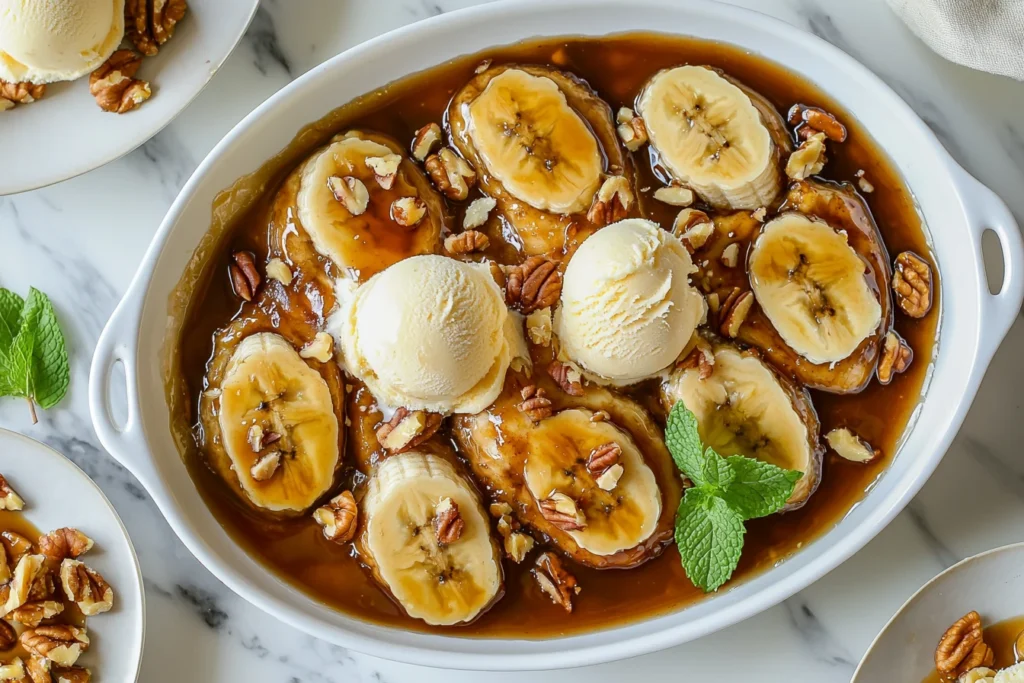
We’d love to hear your thoughts! What ripeness level do you prefer for banana foster? Share your tips and experiences in the comments below!

